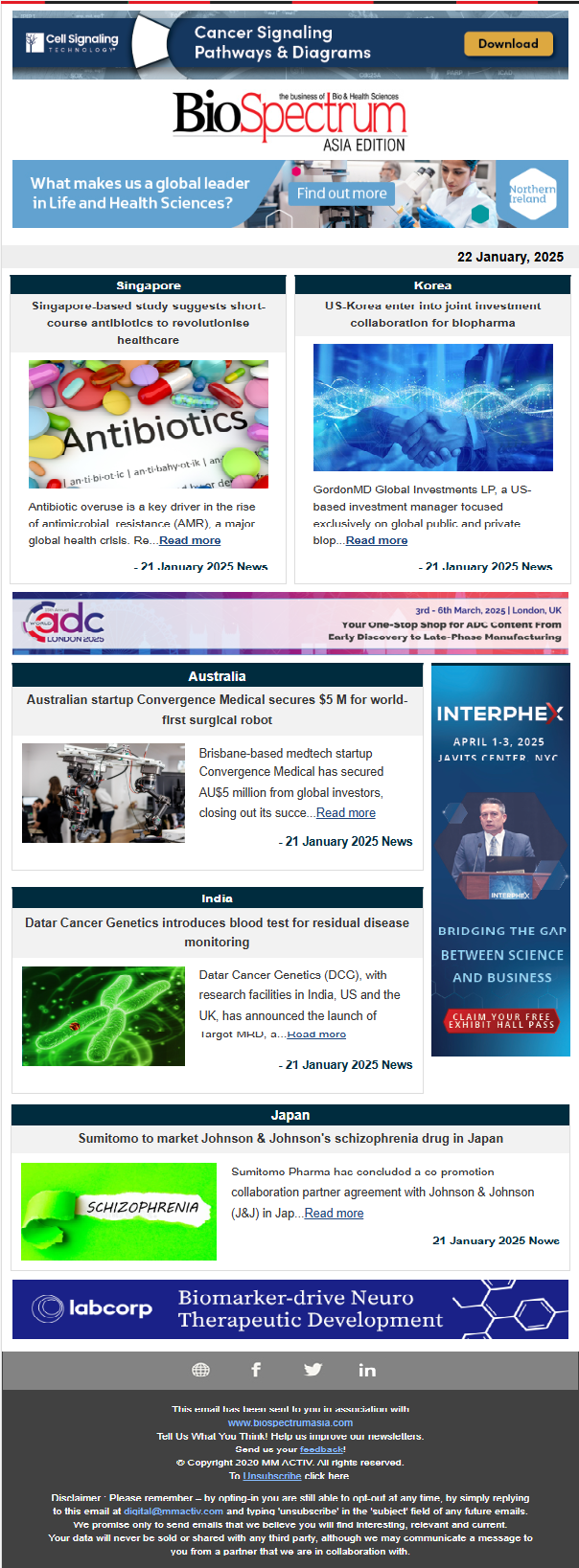
How does the Oncomine Dx Express Test Multi-CDx System improve on your earlier Oncomine Dx Target Test, and what impact could it have on cancer care in Asia?
The Oncomine Dx Express Test is our latest dual-use companion diagnostic (CDx) for both tissue and liquid biopsy samples, compared to the prior Oncomine Dx Target Test which supported only tissue samples. The Oncomine Dx Express Test July submission to Pharmaceuticals and Medical Devices Agency is for tissue, with a liquid biopsy submission planned for the future. Additionally, Oncomine Dx Express Test runs on the Genexus Dx system, our rapid automated next-generation sequencing (NGS) platform that can deliver results in as little as 24 hours. This speed enables more timely treatment decisions for patients. The automated Genexus system also makes it possible to implement NGS testing in smaller local hospitals without requiring prior expertise, bringing testing in-house today. The Oncomine Dx Express Test has the potential to expand NGS access and accelerate treatment decisions across Asia.
Cancer is the leading cause of death in Japan, with more than one million new cases diagnosed annually. By enabling local and regional hospitals to conduct advanced genomic testing themselves, the Express Test shifts testing from centralised to decentralised models. This could accelerate equitable access to targeted therapies across Asia’s diverse healthcare systems, from major urban cancer centers to smaller community hospitals.
With results available in as little as 24 hours, how do you see rapid turnaround times changing treatment decisions in oncology?
Recent studies show that about 27 per cent of patients are put on treatment before molecular results come back. This is because NGS often takes too long to report results, compared to IHC results. Consequently, patients are frequently treated with immunotherapy or chemotherapy first while waiting for NGS results. Toxicity can become a major issue when patients must switch from immunotherapy to targeted therapy. Faster turnaround time helps ensure patients can begin the right treatment upfront, avoiding the toxicity associated with switching therapies.
The difference between days and weeks can completely change a patient’s treatment path. With results in 24 hours, oncologists can move toward precision oncology. Instead of starting empiric therapy and waiting weeks for genomic data, a patient could be diagnosed on Monday, have their molecular profile ready by Tuesday, and begin the right targeted treatment before the week’s end. This reduces unnecessary toxicity, avoids delays in care, and increases the likelihood of patients receiving the most effective therapy at the first line.
Companion diagnostics are becoming central to oncology drug development. What trends are you seeing in pharma–diagnostic collaborations globally and in Asia?
Over the past decade, NGS has become established as the preferred companion diagnostic method for targeted therapies compared to single-gene PCR or FISH methods. Within NGS-based CDx testing, we have seen two models: single-site US central lab CDx and globally distributed product CDx. Increasingly, pharma companies recognise the benefits of globally distributed product CDx, which enables in-country testing and better aligns with global drug launch needs. In recent years, an increasing number of pharma companies have requested outside-US CDx for their drugs after initial approval in the US with single-site central lab CDx.
We’re also seeing a broader shift in how pharma approaches partnerships. Historically, companion diagnostics were sometimes treated as an afterthought, developed late in Phase 3 trials. Today, companies increasingly initiate collaborations as early as Phase 1 to ensure diagnostics are ready alongside the drug at launch. In Asia specifically, regulatory dynamics play a large role: Japanese regulators require targeted therapy/CDx co-launch, Chinese regulators mandate in-country validation studies, and Southeast Asian systems demand affordable, scalable solutions. Pharma partners are therefore thinking globally but executing regionally and choosing platforms that are already distributed and accessible in their target markets. By aligning diagnostics with diverse healthcare landscapes, these collaborations accelerate patient access and support simultaneous or near-simultaneous drug launches worldwide.
What are the biggest challenges for scaling NGS adoption in routine clinical practice—cost, access, or integration into hospital workflows?
NGS has become very comprehensive and robust in the past decade, supporting large gene panels, complex biomarkers, and multiple sample types. The next step is broadening access so patients in community settings and hospitals of all sizes can benefit. This requires an automated system that non-NGS users can operate and that delivers results in an easy-to-understand report for clinicians.
While costs have decreased as the technology has matured, workflow integration remains the main hurdle. Many hospitals operate with limited staff and tight schedules, making it difficult to manage complex sequencing workflows or hire dedicated molecular experts. Automation addresses this challenge by turning sequencing into a streamlined process that non-specialists can operate on. In Asia—where access to care can vary greatly between urban centers and rural clinics—automation helps make NGS as routine and accessible as other common lab tests, enabling broader patient reach and equity in care.
Looking ahead, how do you see automation and AI shaping the next generation of diagnostics and personalised medicine?
History shows that automation has been critical to democratising new technologies. For example, immunohistochemistry (IHC) became widely adopted once automation made it usable by non-expert labs. The same principle applies today with NGS. In an increasingly complex treatment landscape — including targeted therapy, immunotherapy, ADCs, and chemotherapy — AI holds enormous promise to aid clinicians in making informed decisions among many different treatment pathways. AI can help oncologists navigate these options by highlighting patterns and predicting responses that might otherwise be missed.
For Asia, where healthcare systems vary widely in resources and expertise, the combination of automation and AI offers a way to level the playing field. From advanced academic centers in Singapore and Japan to smaller hospitals in Southeast Asia, these tools can help ensure patients everywhere benefit from the same high standard of precision oncology.
Ayesha Siddiqui




